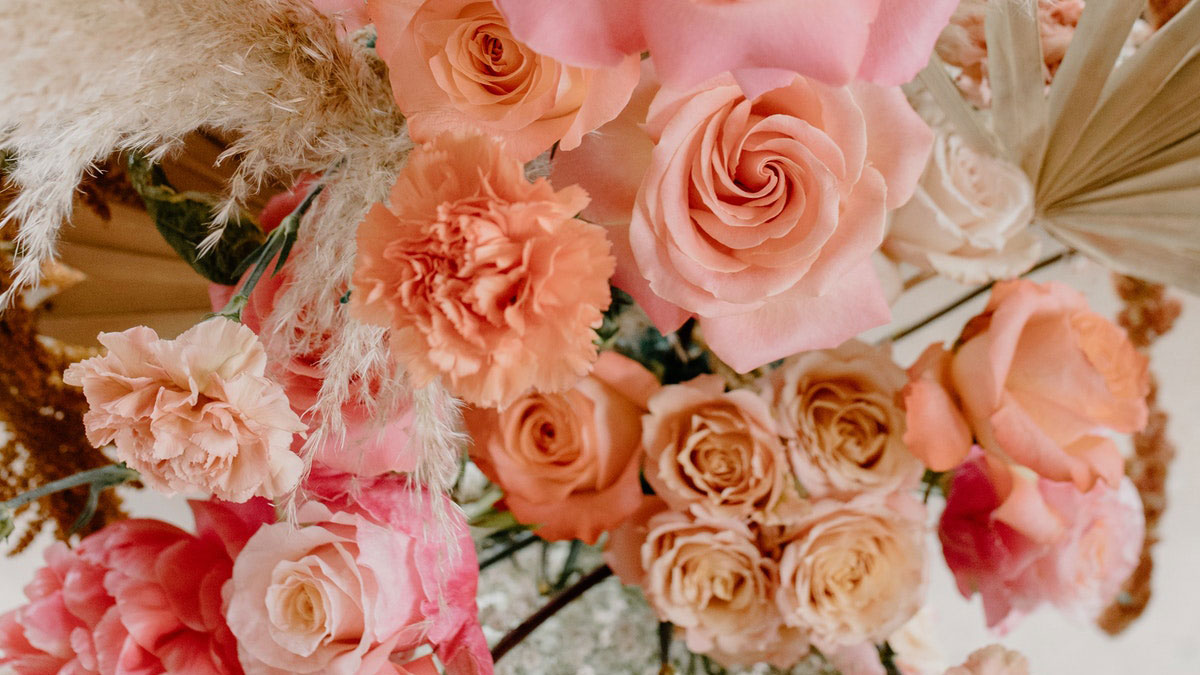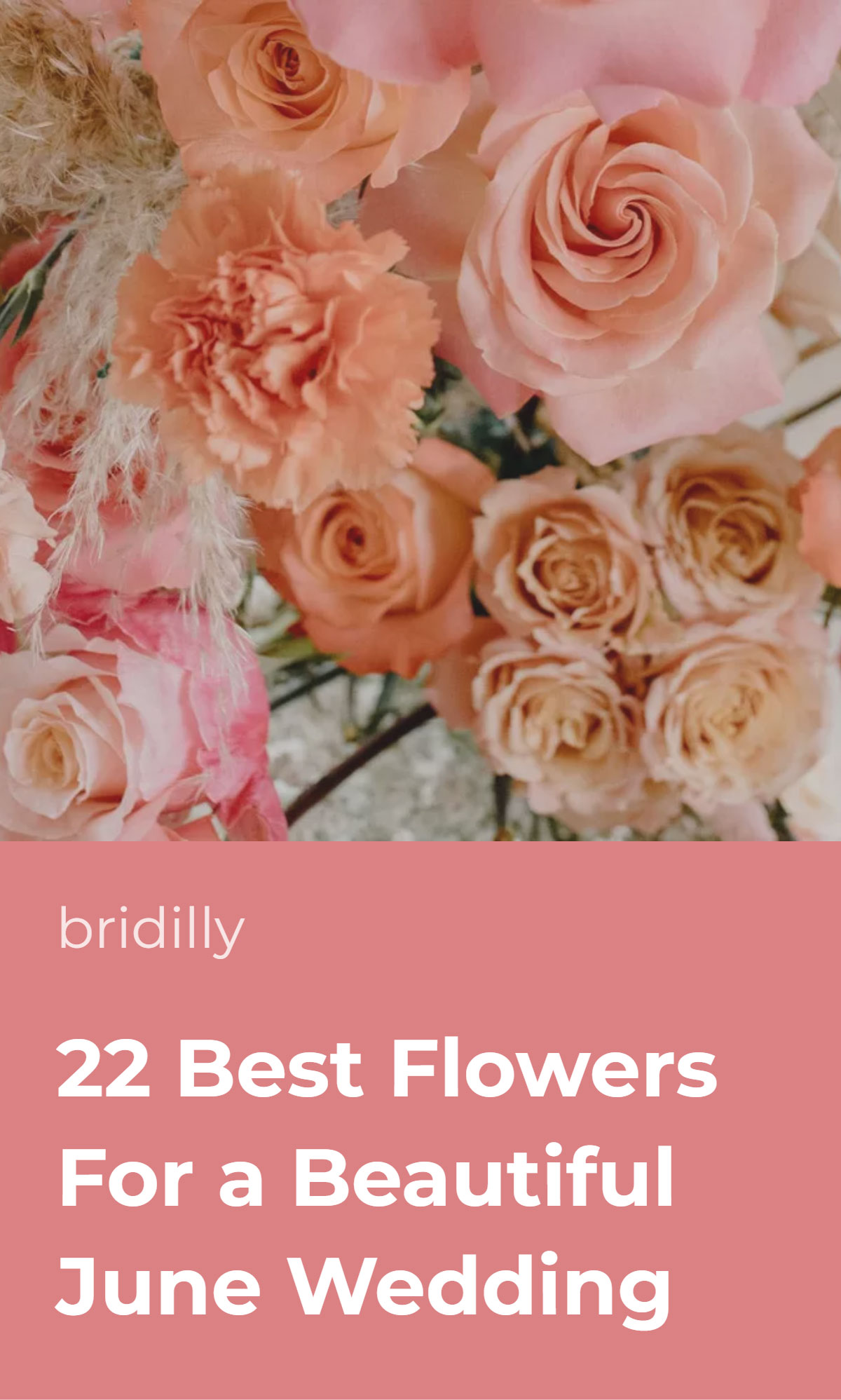Summer brides are the luckiest, as the selection of June wedding flowers is truly endless.
While many flowers nowadays are available year-round, some of the most beautiful varieties only bloom in summer.
Choosing seasonal flowers will ensure that your wedding arrangements stay fresh longer and help you save some money.
Furthermore, summer flowers perfectly match the season’s unique appeal, boasting a plethora of vibrant colors.
If you’re wondering how to choose the right flowers for your wedding among so many stunning varieties, consider your event style, color scheme, and location.
Table of Contents [show]
1. Dahlia
Dahlia is one of the most popular summer wedding flowers, available in an array of sizes, shapes, and colors.
Some dahlias have rounded petals and a spherical shape; others have long, narrow petals and flat tops. There are also two and three-toned varieties.
Dahlias work the best for bouquets and centerpieces, but smaller blooms can also make beautiful boutonnieres and hairpieces. The best thing is that dahlias pair well with nearly any seasonal flower, from traditional roses to exotic protea.
2. Cornflower
Cornflowers are ideal for rustic summer weddings. These vivid wildflowers come in blue, purple, pink, and white colors.
Cornflowers are excellent for bouquets, flower crowns, and venue décor. Combine them with other summer wildflowers like sunflower and gypsophila or garden blooms like dahlia and rose.
3. Lisianthus
Lisianthus is a delicate garden flower with rose-like purple, blue, pink, white, or two-toned blooms. It’s an excellent choice for bouquets, venue décor, and boutonnieres due to its versatility and long vase life.
Lisianthus looks stunning with nearly any garden flower, including roses, carnations, tulips, freesias, and filler flowers like gypsophila and Queen Anne’s lace.
4. Delphinium
Delphinium is an unusual summer wedding flower with a long stem covered with blue, purple, lavender, pink, red, or white blooms.
Delphinium is an excellent addition to any floral arrangement but pairs especially well with hydrangeas, irises, snapdragons, sweet peas, hyacinths, and lisianthus.
Furthermore, delphinium works well as venue décor – even a single delphinium stem in a tall vase makes a stylish centerpiece. However, florists don’t typically use delphinium for boutonnieres and other small accessories.
5. Hydrangea
Hydrangeas are dreamy garden flowers with delicate clustered blooms creating a spherical shape. Hydrangea can add volume and texture to any floral arrangement, making it appear more creative and romantic.
These whimsical flowers mainly come in pastel shades, including sky blue, blush, and cream. However, there are also azure blue and vivid green species.
Hydrangeas pair well with a wide variety of garden flowers, including roses, lisianthus, and ranunculus. However, mono hydrangea bouquets look equally chic as elaborate arrangements.
6. Rose
You can’t go wrong with a rose bridal bouquet, regardless of the season and wedding style. From two-toned Cherry Parfait to sunny Teasing Georgia, there’s a rose variety for any preference.
Furthermore, roses have a long vase life, are always available at florists, and are cost-effective. They go well with most garden and exotic blooms.
7. Carnation
Most people know carnations as long-stemmed garden blooms with medium-sized fringed flowers, but there are so many more beautiful varieties.
For instance, some carnations only reach two inches in height, and others have tiny, clustered blooms on a single stem, resembling a yarrow.
Carnations are versatile and work well in bouquets, boutonnieres, hairpieces, cake décor, and centerpieces. Mix them with other textured garden blooms like dahlias, lisianthus, and roses.
8. Tweedia
Tweedia is a delicate wildflower with tiny, sky-blue blooms and rich greenery. It’s an excellent filler flower that looks stylish in nearly any arrangement, especially with blue, yellow, blush, or white blooms.
However, a mono tweedia bridal bouquet is a dainty choice for a modest bride. It will flawlessly fit rustic or bohemian style, giving your look a carefree vibe.
9. Sunflower
Sunflowers are leading the list of rustic wedding flower favorites from early spring to late fall. These large sunny-yellow flowers never fail to cheer one up and are perfect for bouquets, flower crowns, and venue décor.
The sunflower wedding bouquet ideas are endless – you can pair them with wildflowers like cornflower or Queen Anne’s lace, garden blooms like carnations and dahlias, or exotic flowers like protea and birds of paradise.
10. Lily
Lilies are arguably some of the most attractive summer flowers. These bell-shaped blooms with intense sweet fragrance come in an array of shades, from pure white to vibrant spotted orange and two-toned varieties.
Lilies can be used in bouquets, centerpieces, hairpieces, or boutonnieres and pair well with most garden and exotic blooms.
Brides who prefer minimalism may consider a white calla lily bridal bouquet – this lily variety has a single petal forming a trumpet shape, proving that less is more.
11. Daisy
Everyone knows daisies, but not everyone is aware of all the beautiful daisy types. Every bride gets to pick her favorite, from small, rounded English daises to vibrant flat-topped gerbera daises.
And while some daisy varieties, like oxeye daisy, are widely considered a weed, they still look stunning in summer wedding bouquets.
Garden daisies with large blooms, such as gerbera and painted varieties, go well with dahlias, zinnias, and chrysanthemums. Meanwhile, wild daisies with small blooms can serve as filler flowers for rustic bouquets with cornflowers, sunflowers, or lavender.
12. Lavender
Lavender flowers are so gorgeous that there’s a color named after them. However, lavender comes in different shades, including white, pink, and blue-violet.
Lavender is ideal for rustic and bohemian summer weddings and is pretty versatile in applications – you can use it in boutonnieres, centerpieces, ceremony arch, bouquets, floral crowns, or cake décor.
A mono lavender bridal bouquet is an excellent choice for minimalism lovers. Consider pairing lavender with lilac, delphinium, sweet peas, lisianthus, and other purple blooms or succulents and sage branches.
13. Agapanthus
Agapanthus is a unique flower with dozens of tiny, clustered blooms forming a spherical shape on a long bare stem. The most common colors are blue and purple, though some agapanthuses are pink and white.
Agapanthus is typically used as a filler flower in elaborate floral arrangements and looks especially well with cornflowers, sunflowers, gypsophila, hydrangea, and Queen Anne’s lace.
14. Gladiolus
Delphinium and gladiolus look alike, but the latter has bell-shaped blooms and more color variations, including white, cream, pink, red, purple, green, and two-toned.
Gladiolus can make any floral arrangement more attractive. It’s an excellent choice for modern asymmetric bridal bouquets and centerpieces.
This unusual summer flower looks the best with exotic blooms like lilies, protea, anthurium, or decorative greens like pampas grass.
15. Liatris
Narrow, fluffy liatris flowers may resemble a bottle brush, but it’s an eye-catching addition to any summer bridal bouquet. Liatris comes in purple, white, and pink and pairs beautifully with nearly any exotic, wild, and garden flower.
16. Yarrow
Yarrow is an unusual flat-topped flower with tiny, clustered blooms. Yarrow shades range from white and delicate pastels to vibrant fuchsia and red and dark burgundy hues. Some varieties are two-toned.
A yarrow-only bouquet may look too flat, but it’s a creative and cost-effective filler flower for rustic and exotic floral arrangements.
17. Snapdragon
Snapdragon is yet another long-stemmed summer flower available in a range of vibrant colors, including red, yellow, pink, orange, and multi-colored varieties.
Snapdragons can liven up a classic garden flower bouquet and will beautifully match exotic bloom arrangements. However, a few white snapdragon stems are a chic minimalist alternative to traditional bridal bouquets.
18. Echinops
Echinops’ name originates from Greek for hedgehog due to its spiky globe-shaped head. However, most people know it as a blue thistle.
This unusual bloom ranges from white to deep blue, but florists sometimes dye it vibrant red, pink, yellow, and purple.
Echinops is typically used as an accent flower. The best thing about blue thistle is its versatility – it looks creative with wild, garden, and exotic blooms, giving any bouquet a modern twist.
19. Anemone
You can recognize anemones by rounded petals, flat shape, and large black center. These popular summer wedding flowers come in red, pink, blue, burgundy, and purple, but white anemones are the most common choice.
Anemones look beautiful with roses, ranunculus, dahlias, freesias, peonies, tulips – the list can go on. It truly is one of the most gorgeous and versatile wedding flowers suitable for any style and application.
20. Peony
Peonies come in a rainbow of colors, including delicate peach and blush, vivid fuchsia and coral, and deep burgundy. These voluminous, textured blooms are impeccably elegant and dreamy, so they require a worthy pair.
Combine peonies with roses, carnations, ranunculus, and other garden flowers, or mix and match different peony shades in mono bouquets.
21. Orchid
There’s no exotic wedding flower more popular than an orchid. This elegant bloom comes in all shapes and colors, from pure white to spotted yellow and multi-colored.
You may opt for a modern cascading orchid bouquet, use single orchid blooms as hairpieces and boutonnieres, or decorate your entire ceremony arch with white Phalaenopsis flowers – the orchid wedding decoration ideas are endless.
22. Protea
Protea is among the most unusual wedding flowers, featuring a long stem and conelike head with clusters of long, tubular flowers that look like petals.
Proteas come in pink, red, white, cream, and yellow colors and look the best with other exotic blooms or textured garden flowers like dahlia and zinnia.















No Comments Add one
Leave a Comment